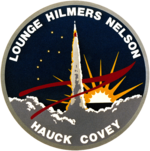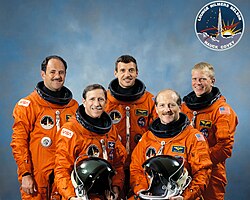STS-26
| Mission emblem | |||
|---|---|---|---|

|
|||
| Mission dates | |||
| Mission: | STS-26 | ||
| COSPAR-ID : | 1988-091A | ||
| Crew: | 5 | ||
| Begin: | September 29, 1988, 3:37:00 p.m. UTC | ||
| Starting place: | Kennedy Space Center , LC-39B | ||
| Landing: | October 3, 1988, 16:37:11 UTC | ||
| Landing place: | Edwards Air Force Base , Runway 17 | ||
| Flight duration: | 4d 1h 0m 11s | ||
| Earth orbits: | 64 | ||
| Track height: | 376 km | ||
| Orbit inclination : | 28.5 ° | ||
| Covered track: | 2.7 million km | ||
| Payload: | TDRS-3 | ||
| Team photo | |||
 v. l. No. John Lounge, Richard Covey, David Hilmers, Frederick Hauck, George Nelson |
|||
| ◄ Before / After ► | |||
|
|||
STS-26 ( english S pace T ransportation S ystem ) is a mission designation for the US Space Shuttle Discovery (OV-103) of NASA . The launch took place on September 29, 1988. It was the 26th space shuttle mission and the seventh flight of the space shuttle Discovery.
team
- Frederick Hauck (3rd space flight), commander
- Richard Covey (2nd space flight), pilot
- John Lounge (2nd space flight), mission specialist
- George Nelson (3rd spaceflight), mission specialist
- David Hilmers (2nd spaceflight), mission specialist
This was the first shuttle mission without a space novice. While in the previous shuttle flights the pilot was usually (with the exception of STS-61-A ) a newcomer to space, from then on it became increasingly common to use astronauts twice as pilots and only then to be promoted to commanders.
The crew division was based essentially on the crew originally intended for the STS-61-F mission, which should have started in 1986 but was canceled as a result of the Challenger disaster. Hauck, Lounge and Hilmers had been assigned to this flight, with Roy Bridges as the pilot. Bridges was replaced by Covey, and Nelson joined the crew.
Mission overview
After an interruption of over two and a half years caused by the Challenger disaster , the shuttle program was resumed with this mission. This also returned to the original numbering system. Since the STS-51-L was the 25th shuttle flight, the successor mission was named STS-26.
The start was 98 minutes late because a malfunction in the cooling system of the suits of two crew members had to be fixed.
In addition to conducting a large number of experiments of all kinds, the mission exposed the TDRS-3 communications satellite . Almost all of the mission objectives could be achieved. A disruption in the space shuttle's climate system caused the temperature inside the Discovery to temporarily rise to around 30 ° C.
The landing was on schedule at Edwards AFB , California . Discovery was transported back to Cape Canaveral , Florida five days later by special aircraft.
Wake-up calls
On the second day, a wake-up call was broadcast from Robin Williams , who was supposed to wake up the Discovery crew with “Good Morning Discovery” based on his role in the film Good Morning, Vietnam .
See also
Web links
- NASA Mission overview (English)
- Video summary with comments of the crew (English)
- STS-26 in the Encyclopedia Astronautica (English)
Individual evidence
- ^ Youtube: Robin Williams STS-26 "Good Morning Discovery" wake-up call. Retrieved November 3, 2014 .
